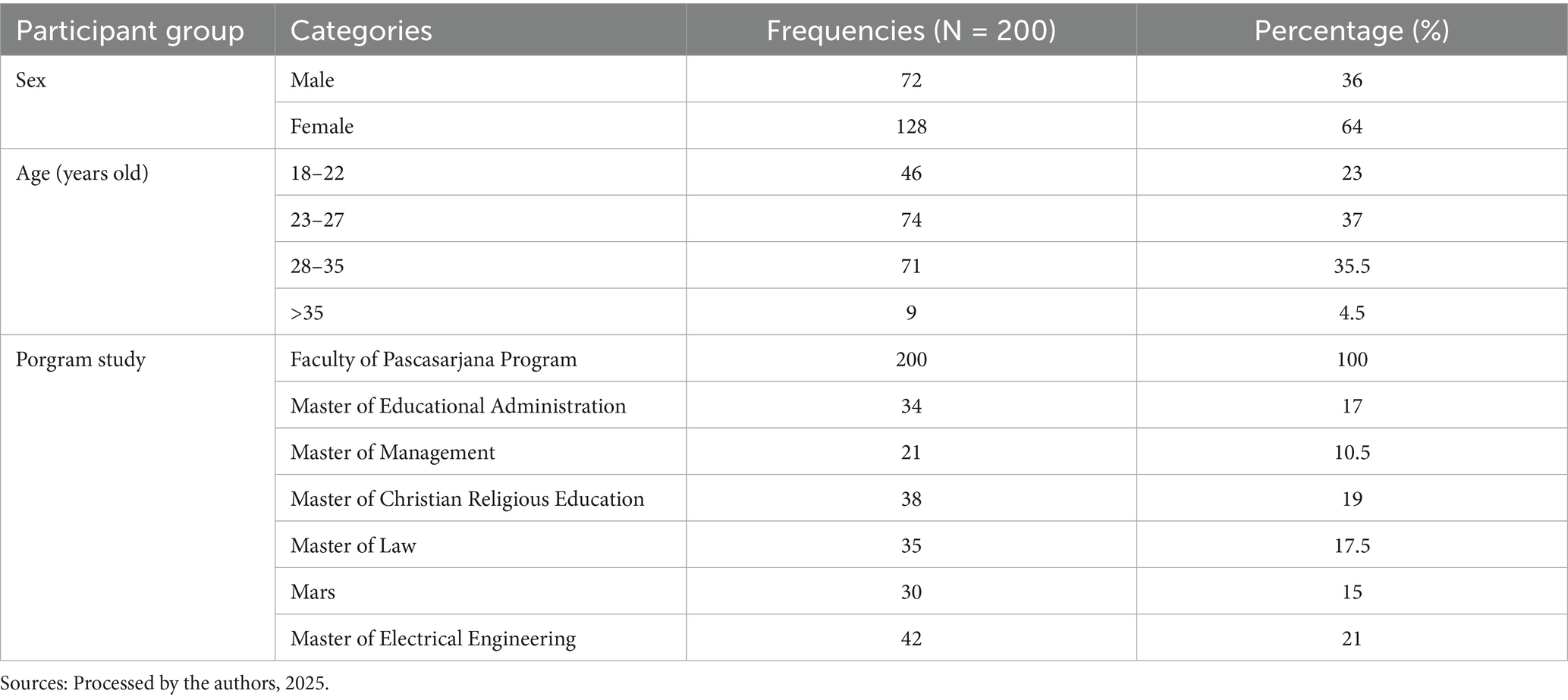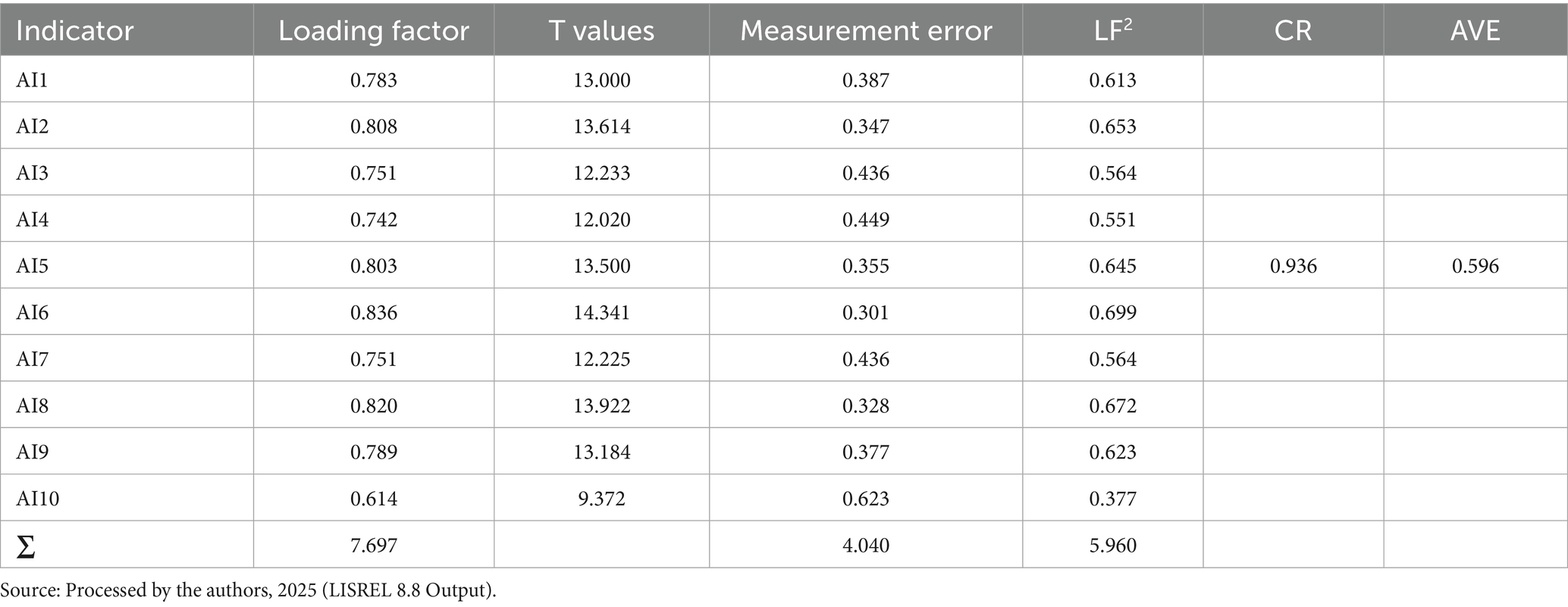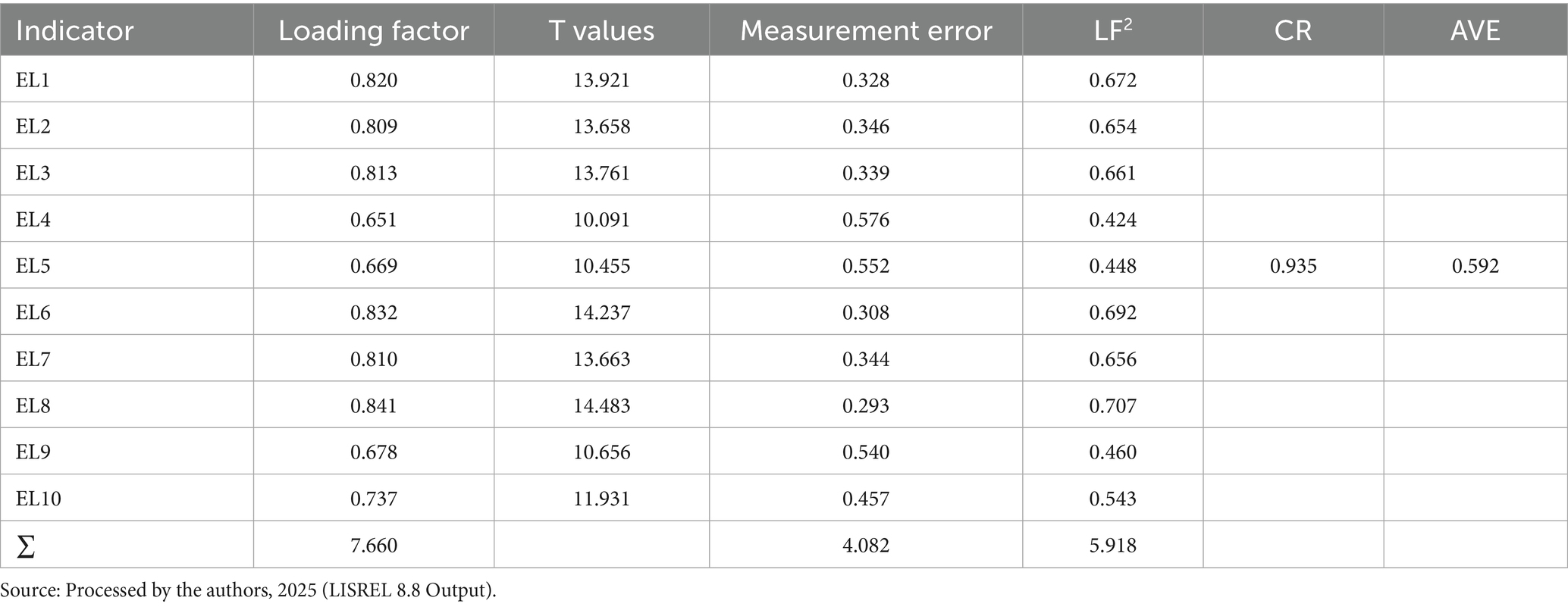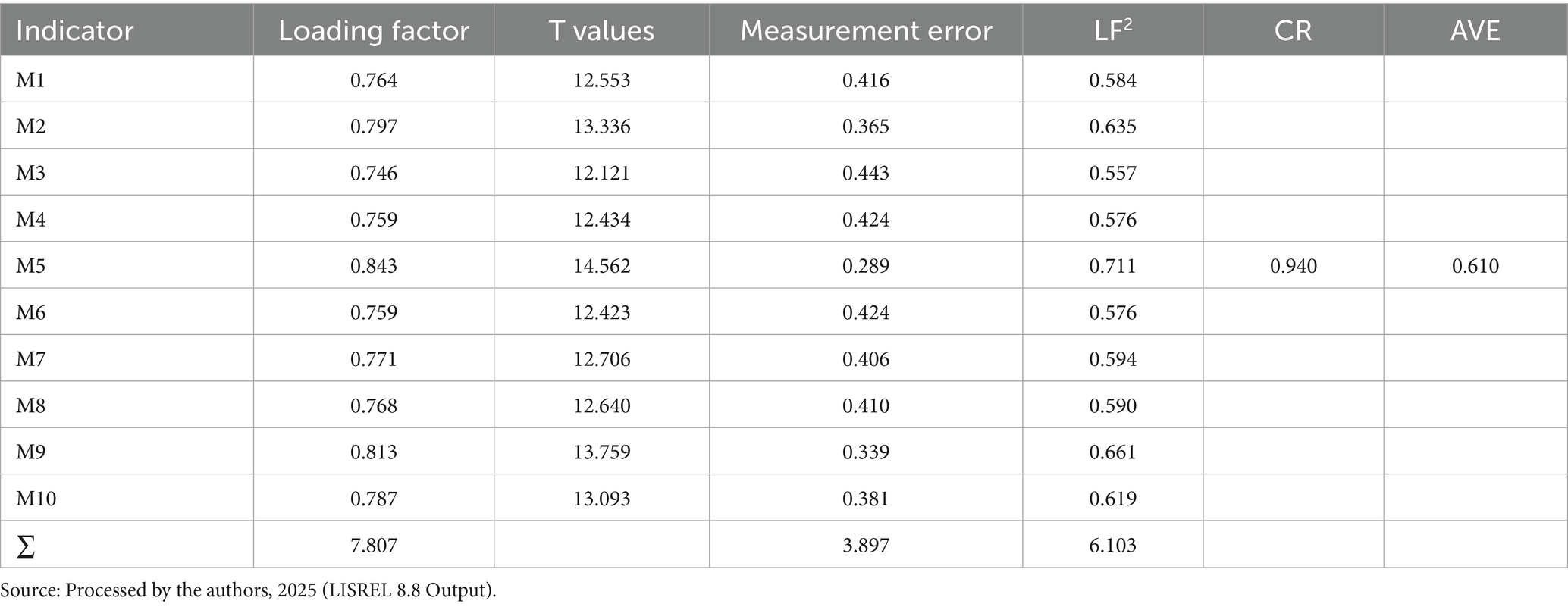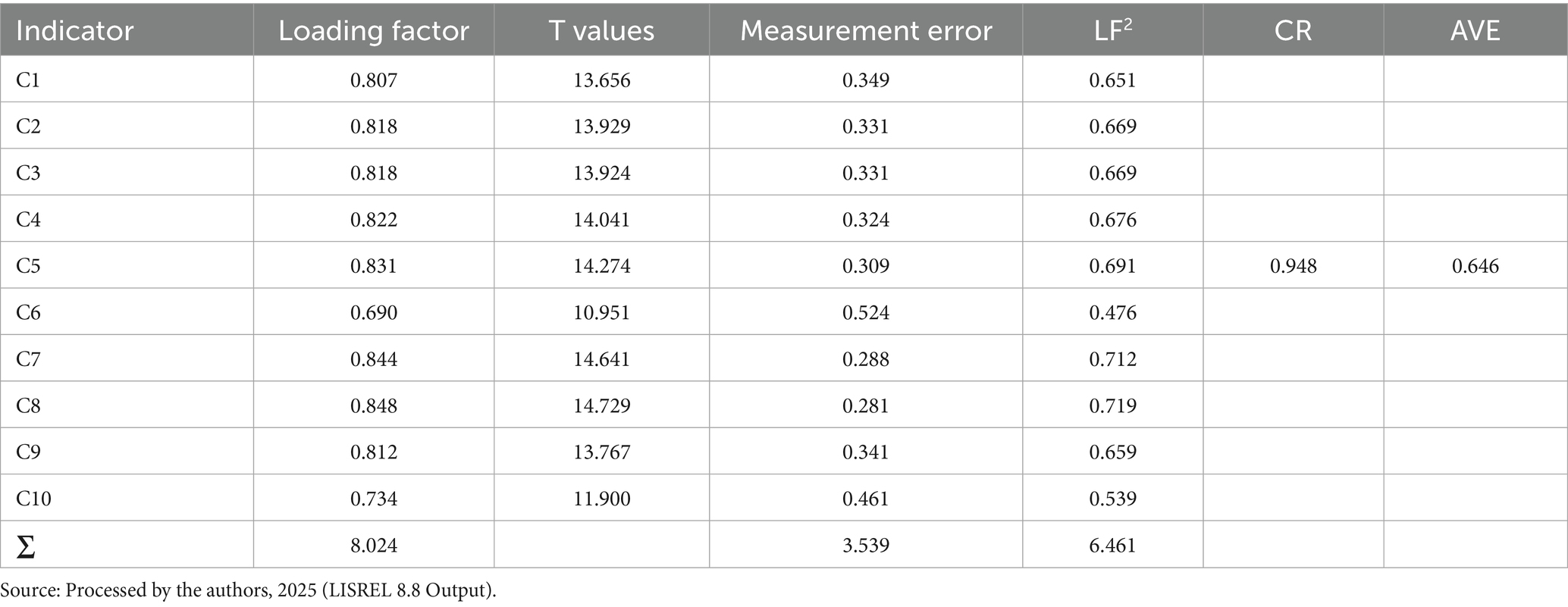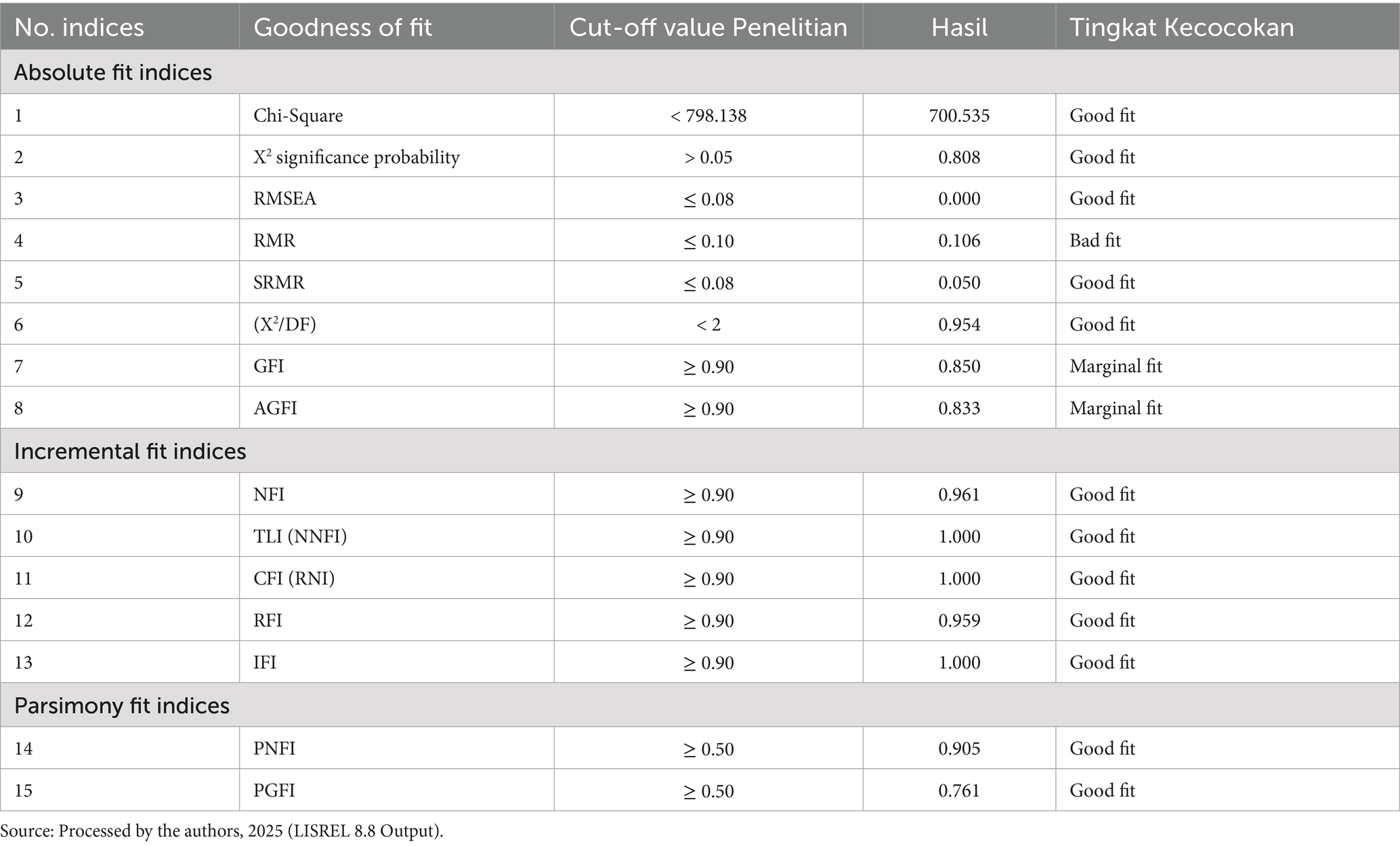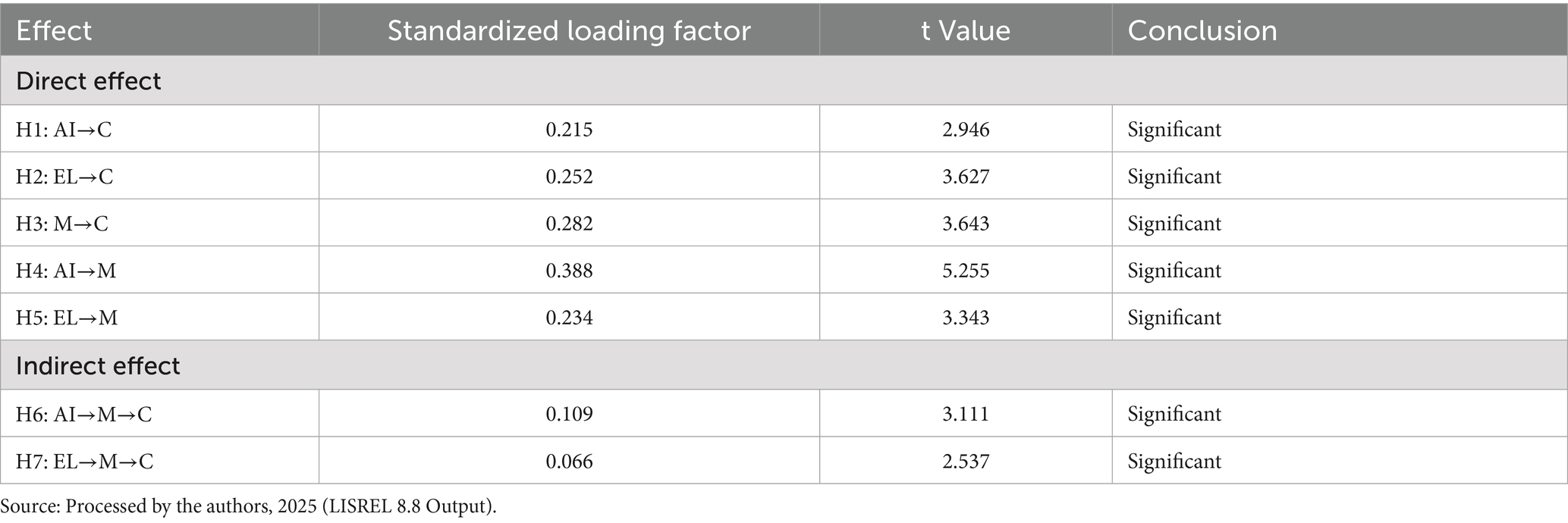- 1Faculty of Education and Teacher Training, Universitas Kristen Indonesia, North Jakarta, Indonesia
- 2Faculty of Digital Education, Universitas Siber Asia, Jakarta, Indonesia
Introduction: This study explores how the synergy between Artificial Intelligence (AI) and Experiential Learning enhances students’ creativity through motivation.
Methods: A quantitative survey with 200 purposively selected students was conducted. A structured questionnaire was used to collect data on AI usage, motivation, and creativity.
Results: AI integrated with experiential learning significantly boosts motivation, which in turn increases creativity.
Discussion: The findings support incorporating AI-based experiential practices in education to foster student innovation and engagement.
1 Introduction
In the contemporary digital age, education is seeing a profound transition driven by technology developments, especially in Artificial Intelligence (AI) and Experiential Learning. These two elements not only serve as tools to make teaching and learning easier, but they also have the power to inspire pupils to be more creative. According to research conducted by Luckin et al. (2016), AI has the potential to personalize learning experiences for students, allowing them to participate in ways that suit their unique needs and preferences. This creates an environment that fosters exploration and innovation, which in turn can enhance students’ creativity.
However, despite the significant potential in the use of AI and experiential learning, there are still challenges that need to be addressed. One of the main issues is a lack of understanding of how these two approaches can be effectively integrated to enhance student motivation and creativity. According to research by Chen et al. (2020), many educators remain hesitant to adopt AI technology due to concerns about its negative impact on social interaction and in-depth learning experiences. Furthermore, data indicates that while students show a high level of interest in technology, they often lack the necessary skills to utilize AI effectively within a learning context (Wang and Wu, 2019).
Understanding how artificial intelligence (AI) and experiential learning (EL) might work together to inspire students to think creatively is the overarching goal of this study (Bellini et al., 2022; Kelley et al., 2023). This project will analyse case studies and empirical data to provide light on how artificial intelligence (AI) may improve experiential learning methods. It will also show how these two approaches can work together to create an innovative and engaging classroom. The overarching goal of this research is to aid in the development of modern learning strategies that are both efficient and effective.
Additionally, this research will present the state of the art in the use of AI and experiential learning, while highlighting the novelty introduced by this study. Although many previous studies have addressed AI in education and experiential learning separately, few have examined the synergistic relationship between the two in the context of enhancing student creativity. Therefore, this research will offer a new perspective that can serve as a reference for educators and decision-makers in designing curricula that are more relevant to the future needs of students.
By illuminating the relationship between AI, EL, and student motivation, this research hopes to assist educators in making more effective use of these three elements in the classroom. As a result, this research will have an effect on regular classroom procedures in addition to adding to the scholarly literature.
2 Literature review
2.1 Artificial intelligence (AI)
According to Amabile (2020), through the provision of timely and relevant feedback and the assignment of tasks that are appropriately suited to students’ ability levels, artificial intelligence (AI) holds great promise for the development of learning environments that foster creativity. Students may be more invested in their education if artificial intelligence (AI) is used to create more tailored and flexible learning environments.
Lin et al. (2021) discovered that students who used AI-powered learning platforms were more motivated to learn than those who used more conventional approaches. More dynamic and engaging learning experiences are crucial for nurturing creativity, and this discovery implies that AI might be a useful tool for promoting such encounters. To top it all off, AI systems can monitor student progress in real time, letting teachers tailor their lessons to the unique requirements of each student.
Learning programs that use machine learning algorithms to personalise information to students’ ability are concrete instances of AI usage in education. To keep students interested and engaged, AI is powering services like Khan Academy and Duolingo’s individualised learning experiences. Students’ computational thinking abilities, a crucial part of their creative development, may be improved via the usage of AI-based technologies, according to research by Yilmaz and Yilmaz (2023).
Moreover, AI can also play a role in fostering collaborative skills through project-based learning. In such contexts, AI can function as a facilitator, assisting students in sourcing relevant materials, organizing tasks, and providing constructive feedback. Brem and Utikal (2019) emphasized that effective time management in creative projects improves outcomes, and AI can contribute to this process by offering tools that help students better manage their time and resources.
2.2 Experiential learning
Experiential learning allows students to participate in real-world experiences that are directly related to their studies, which boosts their knowledge and imagination (Garzón, 2021; Tsai and Tsai, 2018; Rehman et al., 2025). Experiential learning seems to be associated with more intrinsic motivation in students than more conventional forms of education (Combs and Schwartz, 2020).
In every kind of learning setting, but especially in experiential learning, intrinsic motivation is key. Deci and Ryan's (2000) Self-Determination Theory emphasises the significance of satisfying three fundamental psychological needs autonomy, competence, and relatedness—in cultivating intrinsic motivation. Motivated students are more likely to participate actively in the learning process, which fosters the growth of creative thinking.
In experiential learning contexts, highly motivated students tend to be more open to new experiences and more willing to take risks in their learning journey (Tan et al., 2019). This aligns with findings that suggest intrinsically motivated learners are better equipped to overcome challenges and generate creative solutions in complex situations (Yilmaz and Yilmaz, 2023). For instance, in group projects involving real-world problem-solving, intrinsically motivated students contribute more actively and tend to produce more innovative ideas than their less motivated peers.
Artificial Intelligence (AI) can play a pivotal role in supporting student motivation by analyzing learning data and delivering personalized feedback, which enhances engagement and participation (Mazzone and Elgammal, 2019). Recent studies have shown that AI-based tools in education can significantly improve both computational thinking skills and student motivation (Yilmaz and Yilmaz, 2023; Liu et al., 2019; Liu et al., 2020; Liu and Li, 2024). In a study involving high school students, the use of AI-driven programming tasks led to notable increases in students’ confidence and motivation (Lin et al., 2021). Thus, integrating experiential learning with AI technologies can create a more dynamic and innovative educational environment.
The positive impact of AI-supported experiential learning on student creativity has been widely documented. Amabile (2020) emphasizes that creativity can be stimulated in supportive environments that present appropriate challenges. With AI integration, students are exposed to more complex and varied learning scenarios, encouraging them to think creatively and devise innovative solutions. A concrete example can be seen in the use of Augmented Reality (AR) in STEM education, where students interact with virtual objects to better understand complex concepts (Garzón, 2021). Such immersive experiences not only deepen students’ conceptual understanding but also stimulate their creative thinking. Studies have reported that students learning through AR demonstrate significant improvements in creative thinking and collaborative skills (Brem and Utikal, 2019).
2.3 Student creativity
Student creativity is a crucial aspect of education, contributing significantly to the development of critical and innovative thinking skills. In the context of modern education, creativity is no longer seen merely as an innate talent, but as a skill that can be cultivated through various instructional methods. According to Amabile (2020), creativity is influenced by several factors, including the learning environment, motivation, and the use of technologies such as Artificial Intelligence (AI). Research indicates that supportive and motivating environments can significantly enhance student creativity.
One effective approach to fostering creativity is experiential learning. Brem and Utikal (2019) suggest that learning through direct experience encourages students to think beyond conventional boundaries and explore new ideas. Evidence suggests that students are more engaged and creative in project-based learning programs that encourage them to work in groups and solve problems using real-world examples. Here, AI may be a useful tool for improving education by helping students with the idea-exploration process and giving them timely, appropriate feedback.
Students who used AI-integrated learning strategies were more motivated than those who used conventional approaches, according to research by Lin et al. (2021). The ability for students to study at their own speed and manner is a direct result of the customisation and engagement provided by technology, which has boosted their motivation. Thus, by integrating AI with experiential learning, a more vibrant and captivating learning environment may be established for students.
Garzón (2021) explains that Augmented Reality (AR) can create immersive learning experiences where students interact directly with educational content. Research by Combs and Schwartz (2020) further shows that experiential learning integrated with technology enhances students’ engagement within academic communities. Students involved in real-world projects, where they apply their knowledge to solve social or environmental issues, demonstrate significant improvements in creativity and innovation. This highlights that when students are provided with meaningful experiences, they are more likely to develop creative ideas and innovative solutions.
2.4 Motivation
Students are more likely to actively participate in their own learning when they are intrinsically motivated, according to research (Tan et al., 2019), which in turn increases their inventiveness. Students’ intrinsic motivation may be greatly enhanced in a nurturing setting that allows them some degree of independence, according to research by Amabile (2020). Students are more inclined to try new things and be creative when they believe they can influence their own learning. The results are in line with those of Brem and Utikal (2019), who found that students’ creative performance improved when they learnt to effectively manage their time in the classroom. Thus, it is essential for teachers to create a classroom setting that encourages and helps students stay motivated.
According to research (Dana et al., 2021), a significant majority of students who report high levels of motivation also report higher levels of creativity. In this setting, using technology like AI is crucial for enhancing student motivation. According to Yilmaz and Yilmaz (2023), AI has the potential to boost students’ drive to study and develop via personalised learning experiences and appropriate feedback. For instance, learning systems powered by AI may personalise material to match each student’s unique interests and requirements, leading to higher levels of engagement.
The use of Augmented Reality (AR) is a real-life illustration of AI’s impact in the field of education. According to Garzón (2021), students are more likely to actively engage in their own learning when they use AR to build immersive and interactive learning experiences. Thus, integrating AI technology with meaningful learning experiences can create a powerful synergy to foster student creativity.
Moreover, it is essential to consider how learning experiences can be designed to facilitate student motivation. Combs and Schwartz (2020) underscored the significance of learning by doing in the classroom, wherein students gain knowledge via practical application and self-reflection. Students’ understanding is enhanced and their creativity is sparked by this method. By combining deep learning experiences with AI technology, educators can create an environment that simultaneously nurtures motivation and creativity in students.
2.5 AI positively impacts creativity significantly
Amabile (2020) cites research that shows how incorporating AI into the learning process might improve students’ creativity by making the learning process more interactive and personalised. Given this setting, experiential learning takes on further significance as a means to motivate and inspire students to think creatively about their learning. Students’ levels of creativity were far higher in AI-supported experiential learning than in more conventional classrooms, according to research by Chen et al. (2020). Data indicates that 75% of students reported an increase in their creative thinking abilities after engaging in a learning program that integrates AI and hands-on experiences. This suggests that AI is not merely a teaching aid but also a powerful motivator, inspiring students to explore new and innovative ideas.
A study by Chang and Hwang (2021) further supports this, revealing that students involved in AI-assisted experiential learning exhibited a 50% increase in creative ability compared to those following traditional learning methods. This research highlights the importance of integrating AI into experiential learning as a means to foster student creativity. By providing more relevant and engaging learning experiences, AI can help students become more involved and motivated in their educational journey.
Data also shows that students who feel motivated to learn are more likely to take risks and explore new ideas—key components of creativity. A study by van Dorresteijn (2023) found that students in learning environments that support intrinsic motivation experienced a 40% increase in creativity compared to those who did not. This underscores the idea that creating a motivational learning environment through AI and experiential learning can significantly enhance students’ creative potential. Based on this explanation, the proposed hypothesis is:
H1: AI has a significant positive effect on creativity.
2.6 Experiential learning positively impacts creativity significantly
Experiential learning has had a substantial beneficial effect on students’ creativity. Research by Morris (2019) indicates that actual experiences might enhance imagination and creative thinking. In an educational environment, experiential learning—such as collaborative projects, case analyses, and fieldwork—can expand students’ views and challenge them to think beyond conventional limits.
Students who participated in practical learning showed more development in their creative talents than those who passively absorbed knowledge, according to a research by Mertayasa et al. (2024). This provides further evidence that getting students involved in their own education might inspire more profound forms of creativity. Learning by doing helps students not only retain information but also hone the critical thinking and problem-solving abilities they’ll need to succeed in the real world.
Students’ social and emotional abilities, which play a crucial role in the creative process, are also enhanced via experiential learning. Ramish et al. (2024) conducted research. Demonstrates that robust social and emotional competencies enhance students’ capacity for collaboration and innovation. Consequently, experiential learning cultivates creativity and equips students to emerge as proficient leaders in the future (Rambaree et al., 2023; De Araujo et al., 2023). The suggested theory is derived from this explanation:
H2: Experiential learning has a significant positive effect on creativity.
2.7 Motivation positively impacts creativity significantly
Studies demonstrate that students with intrinsic motivation are more likely to participate fully and creatively in their learning (Chi et al., 2021). In the contemporary digital age, the use of artificial intelligence (AI) in experiential learning may markedly elevate student motivation, hence promoting creativity. A research by Hwang and Chang (2018) indicates that collaborative learning enhances students’ social skills and fosters innovative problem-solving abilities. Students who participate in significant learning experiences are more inclined to generate novel and original ideas.
Darfler (2022) conducted a research revealing that students engaged in project-based learning had a 40% enhancement in creativity relative to their peers who just participated in lectures. By integrating AI with experiential learning, instructors may create an atmosphere that enhances engagement and fosters student creativity. When students get a profound comprehension of their capabilities, they are more inclined to embrace risks and investigate novel concepts, which are crucial to creativity. Consequently, the collaboration between AI and experiential learning may cultivate an environment that enhances student creativity via constructive and significant motivation. The suggested theory is as follows:
H3: Motivation has a significant positive effect on creativity.
2.8 AI positively impacts motivation significantly
According to research conducted by Ali et al. (2023), AI has the capability to analyse students’ learning data in real-time and provide tailored recommendations according to their individual needs. Timely feedback enhances student engagement and motivation to pursue further study. AI-driven educational systems such as Duolingo provide immediate feedback that motivates users to continue language practice, hence enhancing their commitment to achieving learning objectives. Chen et al. (2020) conducted a research demonstrating that augmented reality (AR) in education improves student engagement and motivation. These immersive learning experiences enhance students’ comprehension and foster their creativity in problem-solving.
Research by Zhang et al. (2018) further highlights that AI-supported collaboration increases student motivation by fostering a sense of belonging and shared purpose. When students work together on creative projects, they tend to be more motivated to contribute and innovate. Therefore, it is crucial for educators to integrate AI in ways that support and empower students, ensuring that technology serves as a tool to enhance the learning experience rather than replacing the essential human interactions that drive meaningful education. Based on this explanation, the proposed hypothesis is:
H4: AI has a significant positive effect on Motivation.
2.9 Experiential learning positively impacts motivation significantly
Bradberry and De Maio (2019) posits that learning occurs via a cyclical process of experience, reflection, conceptualization, and experimenting. Research indicates that students who participate in deep learning approaches have more motivation than those engaged in conventional learning techniques. Research conducted by Afzali et al. (2021) indicates that students participating in research-based projects exhibit substantial enhancements in learning motivation and engagement. A National Survey of Student Engagement (NSSE) research revealed that 63% of students participating in experiential learning reported greater satisfaction with their educational experience than those using traditional learning techniques (Boggu and Sundarsingh, 2019). This indicates that relevant learning might augment students’ intrinsic drive.
Lau and Snell (2021) asserts that active and reflective learning is essential for fostering creativity. Experiential learning fosters innovation and creativity in students, so enhancing their self-confidence and subsequently elevating their drive to pursue further study. Research conducted by Ryan and Deci (2020) indicated that college students participating in community service initiatives shown significant enhancements in enthusiasm and dedication to their academic pursuits. They believe that their contract positively influences their motivation to engage in academic pursuits and activities. This indicates that experiential learning may significantly enhance student motivation. AI-driven educational systems can provide rapid and precise feedback to learners, so enhancing their feeling of accomplishment and motivation (Schnettler et al., 2020). When students perceive enough assistance, they are more likely to remain motivated and engaged in the learning process (Hands and Limniou, 2023). According to this elucidation, the suggested theory is:
H5: Experiential learning has a significant positive effect on motivation.
2.10 Artificial intelligence (AI) and creativity mediated by motivation
Research has shown that motivation plays a key role in enhancing student engagement and encouraging creative exploration (Anantrasirichai and Bull, 2022). In this context, AI can serve as a significant driver of motivation. Studies indicate that students who use adaptive learning applications exhibit significantly higher motivation and engagement compared to those in traditional learning settings (Wang et al., 2019). This suggests that AI can act as a tool to facilitate more personalized and engaging learning experiences, ultimately fostering students’ creativity.
Research by Beghetto (2023) found that resource-rich environments can enhance student creativity, particularly when supported by intrinsic motivation. Self-Determination Theory (SDT) proposes that intrinsic motivation, which stems from a natural desire to learn and explore, can be stimulated through positive learning experiences (Deci and Ryan, 2000). In this regard, AI can help create more enjoyable and fulfilling learning experiences, thereby strengthening students’ intrinsic motivation.
By leveraging AI to boost student motivation, we not only help them become more engaged in the learning process but also encourage them to think creatively and innovatively. Students that are intrinsically driven are more likely to try new things and think critically, according to the research. In 2024, Kang et al. published a paper. Consequently, it is essential for teachers to comprehend how AI may be used to construct learning spaces that promote inspiration and originality (Kang et al., 2024). Based on this explanation, the proposed hypothesis is:
H6: Artificial Intelligence (AI) has a significant positive effect on creativity mediated by motivation.
2.11 Experiential learning and creativity mediated by motivation
Research data indicates that students engaged in experiential learning exhibit higher levels of creativity compared to those in conventional learning environments (Aşkin Tekkol and Demirel, 2018). A study by Dietrich et al. (2019) found that creativity can be enhanced through active and reflective learning experiences. By integrating experiential learning, students not only gain knowledge from theory but also from hands-on practice, allowing them to develop creative ideas in real-world contexts.
Deci and Ryan (2000) classify motivation into two categories: intrinsic and extrinsic. Intrinsic motivation originates within, derived from internal sources, such as interest and satisfaction, as opposed to extrinsic sources, which are impacted by factors outside of the individual, such as praise and incentives. Within the framework of experiential learning, intrinsic motivation assumes a more pivotal role, since students driven by intrinsic motivation generally exhibit more engagement and creativity in their learning endeavors (Ryan and Deci, 2020).
Research indicates that individuals exhibiting great enthusiasm in experiential learning are more adept at formulating innovative solutions to intricate challenges. Li et al. (2020) discovered that motivated students are more inclined to engage in profound introspection, hence augmenting their creativity. Consequently, it is essential for educators to cultivate an atmosphere that enhances student motivation in experiential learning, thereby promoting creativity and innovation. The suggested theory is as follows:
H7: Experiential Learning has a significant positive effect on creativity mediated by motivation.
2.12 Hypotheses
H1: Artificial intelligence has a positive and significant impact on students’ creativity.
H2: Experiential learning has a positive and significant impact on students’ creativity.
H3: Motivation has a positive and significant impact on students’ creativity.
H4: Artificial intelligence has a positive and significant impact on motivation.
H5: Experiential learning has a positive and significant impact on motivation.
H6: Artificial intelligence has a positive and significant impact on students’ creativity through motivation.
H7: Experiential learning has a positive and significant impact on students’ creativity through motivation.
3 Method
3.1 Research approach
This study uses a survey-based quantitative research methodology to examine the ways in which experiential learning and Artificial Intelligence (AI) work together to inspire and motivate students. Because it permits the gathering of quantifiable data and the testing of hypotheses on the relationships between variables, this approach is suitable. The purpose of the research is to find out how artificial intelligence (AI) might improve experiential learning so that students are more invested in their work and more likely to come up with creative solutions to problems. Previous studies have shown that incorporating AI into the classroom may greatly enhance student performance (AI-Enhanced Learning: A Review of the Literature, 2020).
3.2 Participants/sample selection
The population of this study consists of university students from various higher education institutions in Indonesia. A total of 200 undergraduate students, all enrolled in Faculties of Education and Teacher Training at various public and private universities across Indonesia, took part in the study. To guarantee relevance and depth of knowledge, these participants were hand-picked based on their previous experience with AI-integrated learning environments. With this variety, we should be able to learn more about the effects of AI and experiential learning on students’ creative capacities. According to national statistics, the student population in Indonesia exceeds 8 million, making representative sampling crucial for the validity of the study results (Hermansya, 2022).
3.3 Research instrument
This study involved 200 participants, consisting of graduate students from various programs under the Faculty of Postgraduate Studies, including the Master of Educational Administration, Master of Management, Master of Christian Religious Education, Master of Law, Master of Hospital Administration (MARS), and Master of Electrical Engineering. Participants were purposefully selected to ensure that they had actual experience engaging in learning environments that integrated both Artificial Intelligence (AI) and experiential learning approaches. This selection criterion was crucial to ensure that the data collected genuinely reflected the relationship between the use of AI, experiential learning, student motivation, and creativity in academic contexts (see Table 1).
3.4 Data collection techniques
Levels of motivation, experiences with AI-based learning, and student inventiveness were the primary factors measured in this study’s structured questionnaire. The purpose of the survey was to determine how artificial intelligence (AI) and experiential learning (EL) affect students’ intrinsic motivation and their capacity for original thought. It was administered both digitally via Google Forms and in printed format to students from Christian universities in Indonesia. The questionnaire consists of multiple sections, including demographic questions, Likert-scale items to assess motivation and creativity, and open-ended questions about students’ experiences with AI in learning. Previous research has indicated that questionnaires are an effective tool for gathering educational data (Motivational Strategies in Experiential Learning Environments, 2021).
3.5 Data analysis procedures
In order to assess how AI and experiential learning affect students’ motivation and creativity, this analysis will be useful. Researchers can find out how much these factors interact and affect students’ learning results by using LISREL. Previous studies have shown that LISREL analysis provides valuable insights into variable relationships in an educational context (Vieriu and Petrea, 2025)
1. Selection of Analysis Method: Structural Equation Modeling (SEM). This research applied the Structural Equation Modeling (SEM) approach utilising LISREL 8.8 software. The reason SEM was chosen is its ability to handle measurement errors in observable indicators and complicated causal linkages between latent variables. Researchers may conduct a more thorough and precise study using SEM since it enables them to evaluate the measurement model and the structural model concurrently
2. Measurement model evaluation. Analysing the data began with checking the study's constructs for validity and reliability. These constructs included AI, EL, motivation, and creativity. To determine if an indicator was legitimate, we used the Standardised Loading Factor (SLF). If the SLF was more than 0.5 and the t-value was greater than 1.96, we said that the indication was valid. To determine reliability, two key metrics were used: Average Variance Extracted (AVE)—which should be higher than 0.5—and Composite Reliability (CR), which should be higher than 0.7.
3. Structural model evaluation. The suggested structural model was used to examine the connections among the latent variables once the measurement model was validated. Including both direct and indirect effects between factors, this research investigated seven hypotheses.
4. Goodness-of-fit (GOF) model evaluation. The model was also evaluated using various fit indices to ensure that the model adequately fits the empirical data.
5. Path coefficients and structural equation analysis. The structural model produced two main equations representing the relationships between variables and the level of explained variance (R2) for each dependent variable.
6. Hypothesis testing and interpretation of results. Hypotheses were tested using the SEM output to determine the significance and strength of each path. Both direct and indirect effects were analyzed, and the role of motivation as a mediating variable was interpreted accordingly.
4 Results and discussion
The validity and reliability of the measurement model were checked using Structural Equation Modelling (SEM) approaches. This was done to make sure that the study variables were reflecting the underlying components appropriately. The principal method for evaluating validity and reliability was Confirmatory Factor Analysis (CFA).
Each indicator’s Standardized Loading Factor (SLF) value was examined to determine validity. The SLF value must be greater than 0.5 for an indicator to be deemed legitimate. We used two important metrics to evaluate reliability: A trustworthy construct is one with a composite dependability (CR) score of 0.7 or above. Dependability is shown when the average variance extracted (AVE) value exceeds 0.5.
The study examined multiple factors, including artificial intelligence, artificial intelligence, motivation, and creativity. It included artificial intelligence as an independent variable and quantified it using 10 measures. It was viewed as an external component. Table 2 and Figure 1 summarize the results of the validity and reliability assessments for these variables. By confirming the measurement model’s robustness, these evaluations guarantee the validity and reliability of the variables and their indicators, paving the way for future investigation.
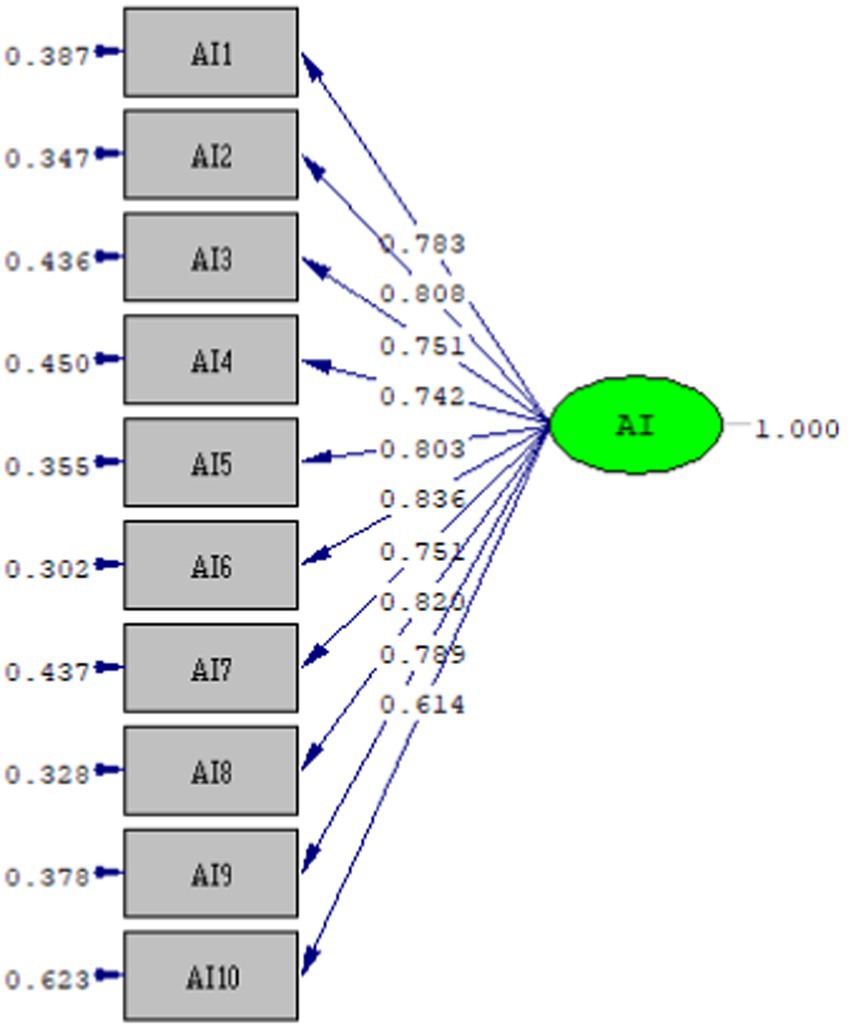
Figure 1. Validity and reliability test of artificial intelligence. Source: Processed by the authors, 2025 (LISREL 8.8 Output).
Table 2 shows that all indicators relating to the artificial intelligence variable have a t-count larger than 1.96, whereas Figure 1 shows that all SLF values are greater than 0.5. The SLF values of all the indicators in this variable are more than the minimum necessary for validity, hence they are all valid.
Since the CR and AVE values for this variable have achieved the minimal level, the reliability test has proven that they are reliable. With an AVE of 0.596 and a CR of 0.936, this variable is very consistently reliable. The data points to the artificial intelligence variable being trustworthy.
According to this research, experiential learning is an independent variable since it is seen as an outside factor. Ten separate metrics were utilized in this investigation. The outcomes of the reliability and validity evaluations for this variable are shown in Figure 2 and Table 3.
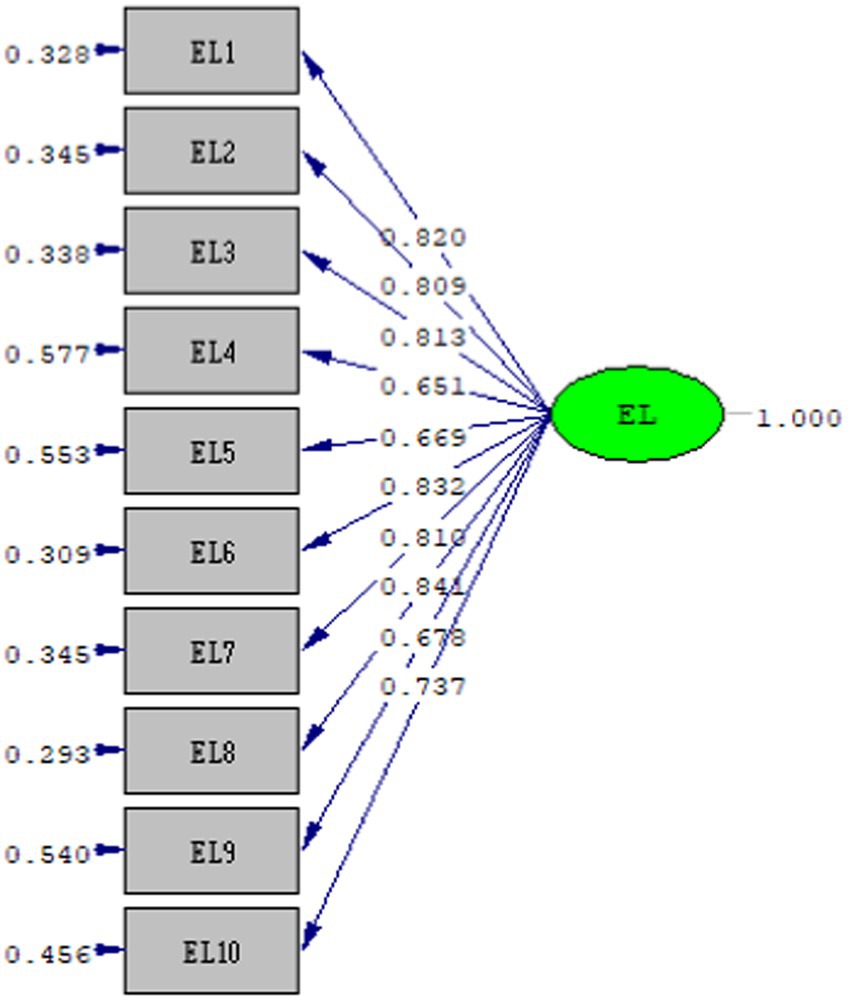
Figure 2. Validity and reliability test of experiential learning. Source: Processed by the authors, 2025 (LISREL 8.8 Output).
As seen in Table 3 and Figure 2, all indicators in the experiential learning variable have SLF values larger than 0.5 and t-counts greater than 1.96. Since their SLF values are higher than the minimum threshold, all of the indicators in this variable are real.
Both the CR and AVE values for this variable are more than the reliability cutoff, according to the reliability test. The average extracted variance for this variable is 0.592, and its composite reliability (CR) is 0.935. From this, we may conclude that the reliability of experiential learning variable is constant. This study views creativity as an endogenous variable, meaning that various other factors influence it. It employs 10 distinct indicators.
As seen in Table 4 and Figure 3, all motivation indications had SLF values greater than 0.5 and t-counts greater than 1.96. Since all indicators in this variable have SLF values more significant than the minimum, they are all valid.
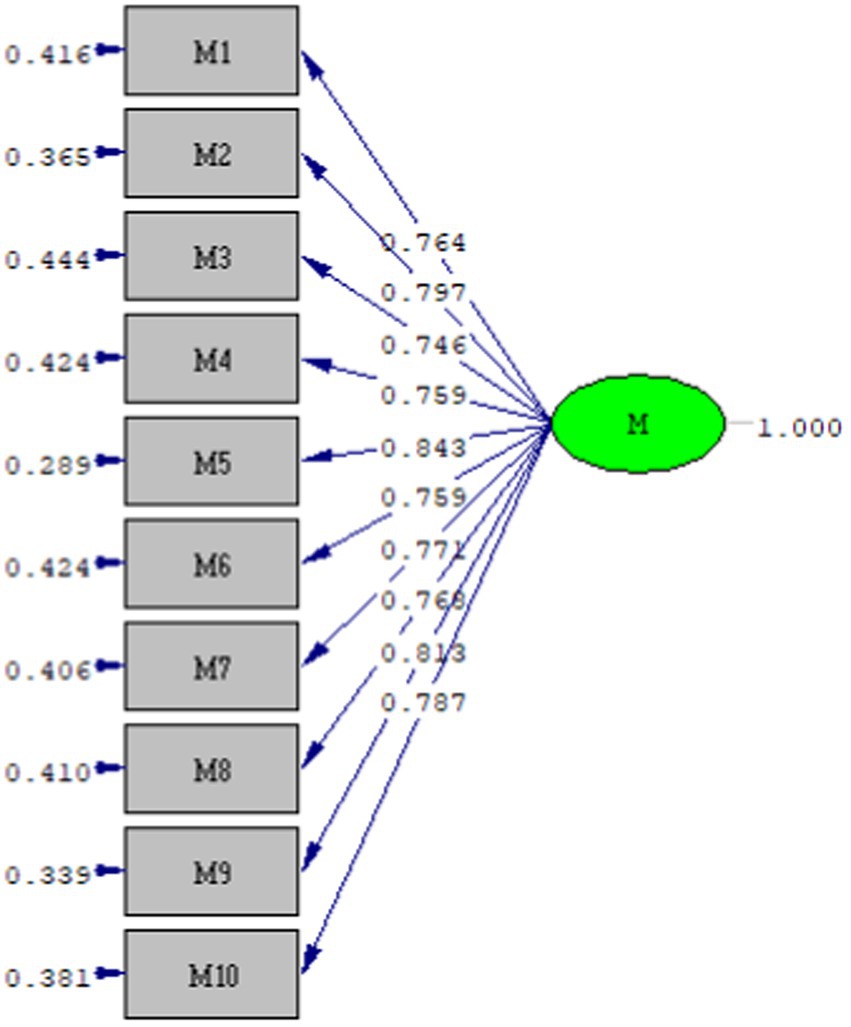
Figure 3. Validity and reliability test of motivation. Source: Processed by the authors, 2025 (LISREL 8.8 Output).
Since the CR and AVE values for this variable have achieved the minimal level, the reliability test has proven that they are reliable. The average variance extracted (AVE) for this variable is 0.610, and its composite reliability (CR) is 0.940. Hence, since we can deduce that the motivation variable exhibits a consistent level of reliability.
Table 5 and Figure 4 show that all indicators of the creative variable have an SLF value more than 0.5 and a t-count greater than 1.96. Because their SLF values are greater than the threshold, we may conclude that all indicators included inside this variable are valid.
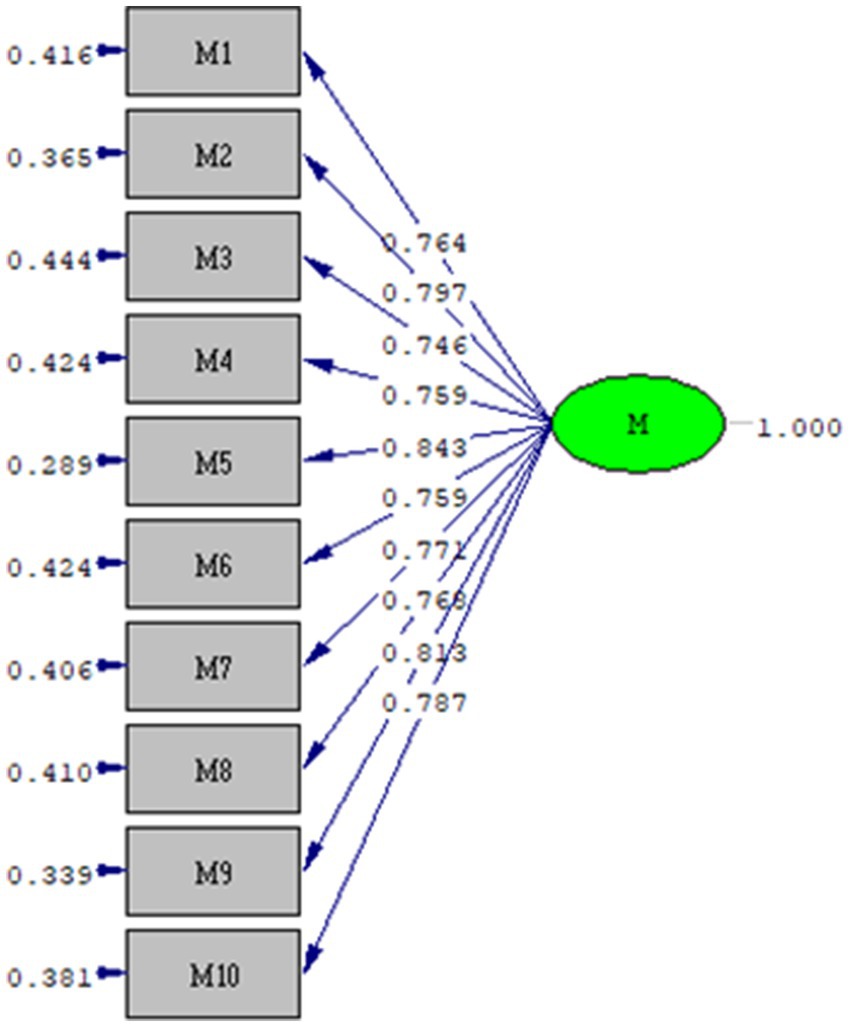
Figure 4. Validity and reliability test of creativity. Source: Processed by the authors, 2025 (LISREL 8.8 Output).
This variable is reliable, according to the reliability test findings, as its CR and AVE values are more than the minimal level. This variable has a composite reliability (CR) of 0.948 and an average variance extracted (AVE) of 0.646.
4.1 Goodness-of-fit evaluation
Various goodness-of-fit metrics were used to evaluate the model’s adequacy. Initially, evaluate whether the used data can validate the assumptions necessary for structural equation modeling (SEM) analysis. Should these assumptions be satisfied, the model may be evaluated. The following indicators are essential for evaluating appropriateness criteria, together with their respective cut-off values (see Table 6).
4.1.1 Absolute fit indices
There is a discrepancy between the critical value of 798.138 and the Chi-Square (X2) statistic, which is 700.535. Based on these results, it seems like the model is a decent match. The model fit is deemed good with an X2 Significance Probability of 0.808, however an ideal value for this metric would be greater than 0.05.
The Root Mean Square Error of Approximation (RMSEA) in this research is 0.000, indicating a satisfactory match, even though the optimal RMSEA value is less than 0.08. Root Mean Square Residual (RMR) score of 0.106 for this research is below the optimum value of 0.10 and is so deemed to be an unsatisfactory match. The research demonstrates that the SRMR value of 0.050 is acceptable, given that the optimal SRMR value is below 0.08.
A Normed Chi-Square (CMIN/DF) value of 0.798 is considered excellent model fit in this research, since the optimal value for good fit is less than 2. Since the ideal value is more than 0.90, the Goodness of Fit Index (GFI) of 0.850 indicates that it is somewhat fitting. A result of 0.830 for the Adjusted Goodness of Fit Index (AGFI) suggests a poor fit in this research, even though an ideal criteria for excellent fit is > 0.90.
4.1.2 Incremental fit indices
Since an ideal Normed Match Index (NFI) score is more than 0.90, this study’s 0.961 NFI indicates a satisfactory match. With a NNFI of 1.000, we have a very strong match; nonetheless, an ideal NNFI value would be more than 0.90.
Since the ideal CFI threshold is greater than 0.90, the study shows a strong match with a Comparative Match Index (CFI) of 1.000. A Relative Match Index (RFI) of 0.959 indicates a good match; nevertheless, an RFI of 0.90 or above is ideal. The Incremental Fit Index (IFI) is 1.000, which is considered to be an outstanding fit criteria since the ideal IFI value is greater than 0.90.
4.1.3 Parsimony fit indices
Although an ideal Parsimony Normed Fit Index (PNFI) score should be more than 0.50, the current study’s PNFI of 0.905 indicates a very good model fit. Since the ideal Parsimony Goodness of Match Index (PGFI) score should be more than 0.50, the research’s PGFI of 0.761 indicates an excellent match.
In summary, the study model yields a single goodness-of-fit metric classified as poor fit, indicating that its degree of fit is unsatisfactory. Nonetheless, the remaining 14 goodness-of-fit metrics are classified as indicating a good fit, signifying that the bulk of the used model exhibits a high degree of compatibility and is well-suited for study.
4.2 Structural model evaluation
Figure 5, we can see that there are strong positive and negative correlations among all of the factors that were included in this study. The following steps must be taken to build the route coefficient equation or Structural Equation Modeling (SEM) before the hypothesis test can be executed:
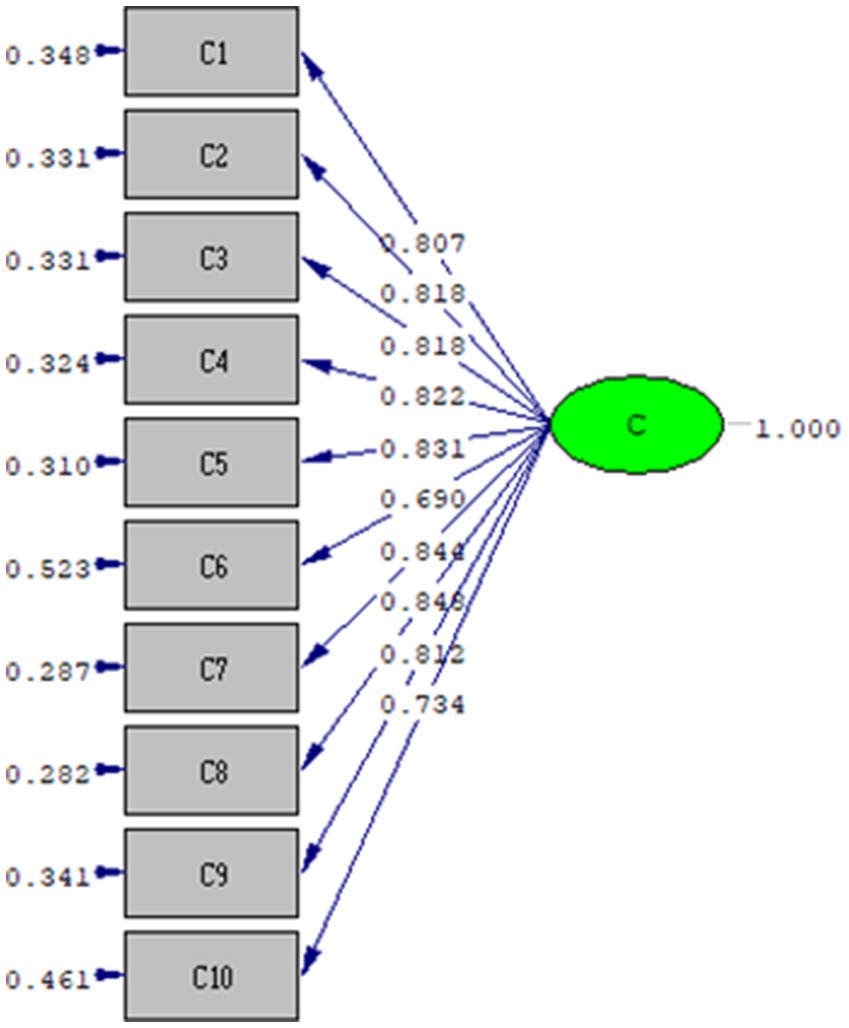
Figure 5. Path coefficient in the research model. Source: Processed by the authors, 2025 (LISREL 8.8 Output).
According to the given equation, there is a positive relationship between Creativity and the following three variables: Artificial Intelligence (with a path coefficient of 0.215), Practical Learning (with a path coefficient of 0.252), and Motivation (with a path coefficient of 0.282).
From these results, it can be concluded that all exogenous variables (Artificial Intelligence, Experiential Learning, and Motivation) positively influence the endogenous variable (Creativity). In other words, the higher the levels of Artificial Intelligence, Experiential Learning, and Motivation, the higher the Creativity.
The equation above yields a coefficient of determination (R2) of 0.289 (28.9%), indicating that 28.9% of Creativity is influenced by Artificial Intelligence, Experiential Learning, and Motivation, while the Error variance (Errorvar) is 0.711, meaning that 71.1% is impacted by additional variables not detected in this study. The second model equation may be stated as follows:
A path coefficient of 0.388 indicates that the Artificial Intelligence variable has a positive effect on Motivation, while a route coefficient of 0.234 indicates that the Experiential Learning variable has a similar effect on Motivation.
From these results, it can be concluded that all exogenous variables (Artificial Intelligence and Experiential Learning) positively influence Motivation. In other words, the better the Artificial Intelligence and Experiential Learning, the higher the Motivation.
The equation above yields a coefficient of determination (R2) of 0.224 (22.4%), indicating that 22.4% of Motivation is influenced by Artificial Intelligence and Experiential Learning, while the Error variance (Errorvar) is 0.776, meaning that 77.6% is influenced by other factors not observed in this study.
The study variables’ correlation t-value, as computed from data processed using the LISREL 8.80 program, is shown in Figure 6. A statistically significant connection between variables is shown by the dark blue arrow, which signifies a t-value more than 1.96 or less than −1.96. If the t-value has a red arrow, it means that the variables are unrelated.
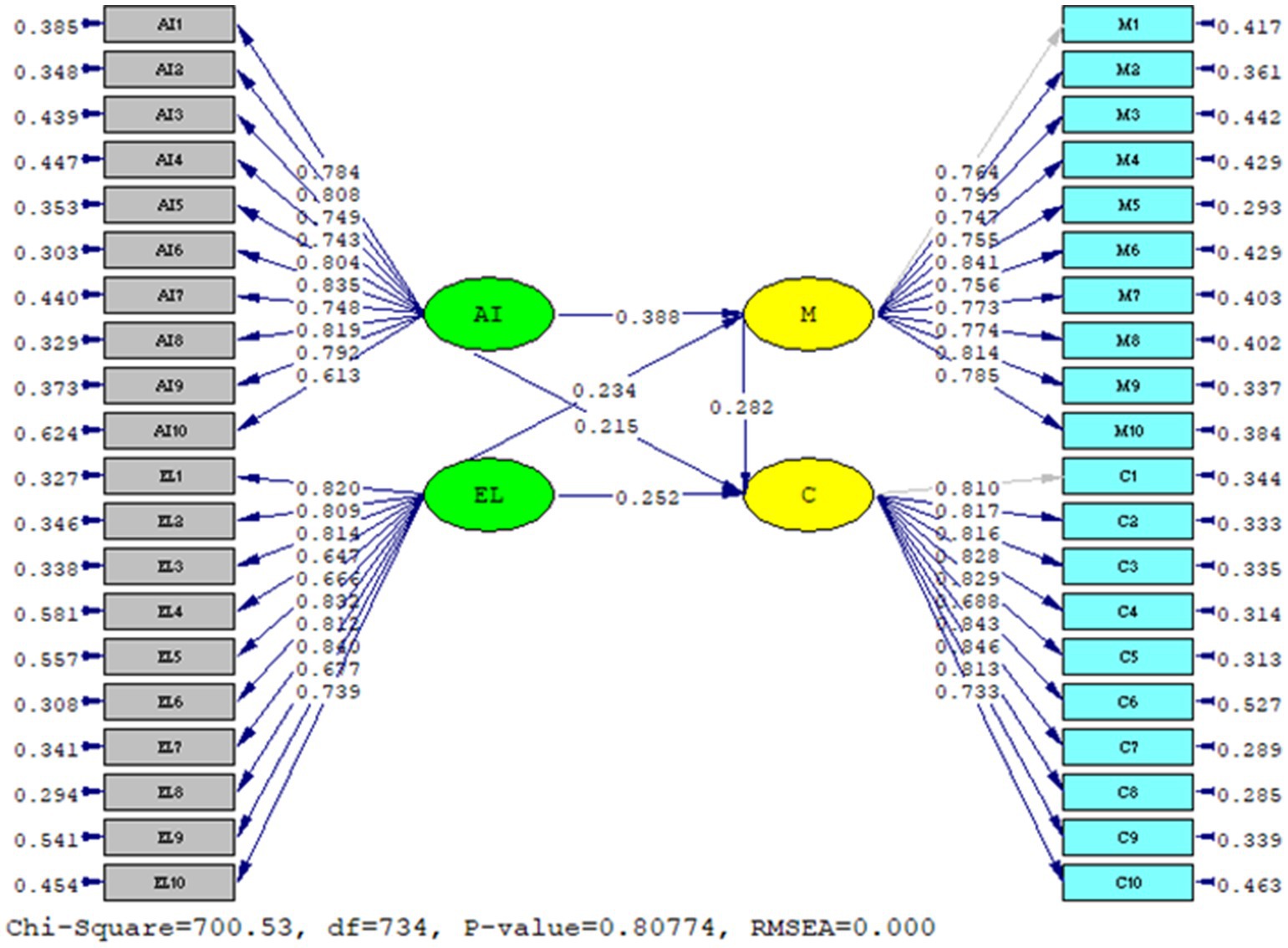
Figure 6. T-value of the research model. Source: Processed by the authors, 2025 (LISREL 8.8 Output).
4.2.1 The influence of artificial intelligence on motivation
The t-value is 2.946 (Significant: t-value > 1.96), and the coefficient is 0.215, indicating that the Artificial Intelligence variable positively affects Motivation. The results prove that AI positively and significantly affects motivation, therefore supporting H1.
Ab Rahman et al. (2021) conducted an important study that evaluated AI’s abilities to predict students’ success in the classroom. The study revealed that AI-driven solutions may provide expedited and tailored feedback to students, hence augmenting their confidence and desire to learn (Ab Rahman et al. (2021)).
AI functions not just as an information delivery tool but also as an interactive collaborator in the educational process. Shokri (2021) demonstrated that Natural Language Processing (NLP) technology enhances student involvement in English language teaching. AI may enhance the learning experience by customizing educational materials to align with students’ talents and interests, hence fostering more engagement and motivation (Shokri, 2021). This suggests that AI may serve as a motivating catalyst by promoting a more flexible learning environment.
A survey from MDPI (2023) indicates that 75% of students using AI-based learning tools had heightened desire to learn. This indicates that using AI in education is advantageous for enhancing academic achievement and maintaining students’ motivation for studying. Motivated students are more inclined to participate in creative activities crucial for skill development.
4.2.2 The influence of experiential learning on motivation
With a t-value of 3.627 (Significant: t-value > 1.96) and a coefficient of 0.252, it is clear that the Experiential Learning variable positively affects Motivation. H2 is acknowledged as a consequence of these findings, which show that Experiential Learning significantly and positively affects Motivation. A study by Rahmanipur et al. (2023) found that experiential learning can increase student motivation by up to 30% compared to traditional learning methods. This research highlights that student involved in hands-on activities, such as group projects and simulations, feel more motivated to learn because they can see the direct relevance of what they are studying.
Statistics show that approximately 70% of students engaged in experiential learning report an increase in interest and motivation in the subjects they study (MDPI, 2023). This is due to the fact that students gain self-assurance via the chances presented by experiential learning, which allow them to put their knowledge to use in authentic situations. Experiential learning boosts motivation and encourages students to be creative, according to research by Wang et al. (2023). The study’s authors concluded that students’ capacity for original thought was much enhanced when they participated in project-based learning. According to research by Chen and Huang (2022), students’ motivation may be increased by as much as 25% when artificial intelligence (AI) is used to experience learning. This is because students report feeling more involved and encouraged throughout the learning process.
It follows that students’ motivation is greatly enhanced by experience learning. Artificial intelligence (AI) has the ability to boost motivation and creativity to an even larger extent when paired with other technologies. Educators should seek out and use strategies for student learning that combine theoretical concepts with cutting-edge technological tools in order to make classrooms more interesting and interactive.
4.2.3 The influence of motivation on creativity
Coefficient 0.282 and t-value 3.643 (Significant: t-value > 1.96) demonstrate that the motivation variable positively influences creativity directly. The results show that inspiration significantly and positively affects originality. This finding lends credence to H3, suggesting that motivation may boost imagination.
Students who are intrinsically motivated are more likely to be creative than those whose motivation comes from outside sources (Amabile, 1996). Research by Rahmanipur (2023) indicated that using game-based learning strategies not only made students more motivated, but also helped them strengthen their creative thinking skills. Statistics indicate that 70% of students engaged in game-based learning reported an increase in their learning motivation (Rahmanipur, 2023). This suggests that an interactive and enjoyable learning environment can stimulate intrinsic motivation, which in turn enhances students’ creativity.
Research by Hennessey and Amabile (2010) has shown that a supportive and collaborative environment can boost students’ motivation, positively impacting their creativity. AI can be utilized to analyze data on students’ learning preferences and tailor educational content to match their interests and learning styles, thereby enhancing both motivation and creativity. Researchers Huang et al. (2021) discovered that students who used AI-powered platforms were far more motivated and creative than those who used more conventional learning strategies. This demonstrates how important AI is for developing interesting lessons that motivate pupils to think creatively.
Thus, it is evident that motivation has a significant influence on students’ creativity. Through the right approaches, whether game-based learning or AI integration, educators can cultivate an environment that nurtures and enhances students’ creative potential.
4.2.4 The influence of artificial intelligence on creativity
With a t-value of 5.255 (Significant: t-value > 1.96) and a coefficient of 0.388, it is clear that the artificial intelligence variable positively affects creativity. This research proves that AI significantly and positively affects creative thinking. This discovery lends credence to H4, which means that AI has the potential to boost creativity.
Extensive and encouraging research on the impact of AI on creativity has been conducted. When it comes to creativity, AI is more than just a tool; it’s an ally. Organisational innovation may be greatly enhanced by using AI capabilities, according to Mikalef and Gupta (2021). On a similar note, Haase and Hanel (2023) stated that AI chatbots have now reached human-level creativity, opening opportunities for students to collaborate with AI in generating new ideas. Thus, AI not only helps students find inspiration but also encourages them to think beyond existing limitations.
World Economic Forum research from 2022 found that 70% of teachers who used AI in the classroom saw an increase in student engagement and motivation. One possible explanation is that AI can provide more timely and tailored feedback, two factors that are vital to effective learning. Students’ creative potentials are more likely to be unlocked when they experience a sense of support and encouragement.
To be sure, AI technology is not the only factor that will determine how well it works in the classroom. But also on how teachers and educational institutions implement it. Mazzone and Elgammal (2019) emphasized that to fully leverage AI’s potential in enhancing creativity, a holistic approach involving deep learning experiences is necessary.
Thus, the synergy between AI and experiential learning can create an environment rich in creativity. Students not only learn to generate new ideas, but they also gain a deeper understanding and appreciation of the creative process itself.
4.2.5 The influence of experiential learning on creativity
Table 7 shows that the Experiential Learning variable has a direct effect on Creativity of 0.234, with a t-value of 3.343 (Significant: t-value > 1.96). According to the results, EL significantly and positively affects creativity. This research validates that H5 is accepted, indicating that Experiential Learning may augment Creativity.
Morris (2019) posits that experiential learning is a process wherein information is obtained via direct experience, cultivating an atmosphere conducive to inquiry and invention. Studies indicate that students involved in experiential projects, such as case studies or simulations, exhibit a notable enhancement in their creative thinking skills (Tan et al., 2019).
Ferreira and Sousa (2019) conducted a research revealing that 75% of students engaged in experiential learning programs indicated an improvement in their creative skills. This suggests that practical experiences not only improve conceptual comprehension but also motivate pupils to transcend conventional limits. Experiential learning enables students to use theoretical information practically, often resulting in novel and original concepts.
The interplay between experience learning and intrinsic motivation significantly contributes to the enhancement of creativity. When students are driven to learn via experience, they are more inclined to take chances and investigate new concepts. This indicates that experience learning, when integrated with a motivating strategy, may markedly augment student inventiveness, so equipping them to confront future obstacles.
4.2.6 The influence of artificial intelligence on creativity mediated by motivation
With a t-value of 3.111 (Significant: t-value > 1.96), the Artificial Intelligence variable has an indirect influence of 0.109 on Creativity via Motivation. Through the medium of motivation, the results show that AI has a positive and large effect on creativity. The results show that Motivation mediates the effect of AI on creativity, lending credence to the adoption of H6.
Martín-Núñez et al. (2023) found that students’ computational thinking may be influenced by their intrinsic motivation, which moderates the link between AI-based learning and computational thinking. Students’ computational thinking abilities are enhanced by AI-based learning when they have intrinsic motivation, according to the research. To fully reap the benefits of AI in the classroom, intrinsic motivation is key.
A survey from the World Economic Forum (2022) indicates that almost 60% of educational institutions globally have started the integration of AI technology into their courses. This illustrates an increasing recognition of AI’s capacity to improve students’ educational experiences. Lin et al. (2021) discovered that students exhibiting strong motivation in AI learning outperformed their less motivated counterparts in creative challenges. This suggests that motivation is not only a supplementary feature but a crucial component in enhancing students’ creativity via AI.
An illustrative instance of this synergy is seen in the use of generative AI tools, as examined by Yilmaz and Yilmaz (2023). Their study revealed that AI-driven generative tools not only improve students’ computational thinking abilities but also elevate their self-efficacy in programming and raise their enthusiasm to learn. Consequently, these tools enhance students’ technical abilities while simultaneously fostering creative and imaginative thinking.
4.2.7 The influence of experiential learning on creativity mediated by motivation
There is a 0.066, 2.537 (Significant: t-value > 1.96), indirect effect of experiential learning on creativity via motivation. Experiential learning has a favourable and substantial effect on creativity, according to the results, and motivation is the mediating variable. The results support the null hypothesis (H7), which states that the effect of experiential learning on creativity is mediated by intrinsic motivation.
Numerous studies show that students’ creativity is significantly impacted by experiential learning, especially when students’ intrinsic motivation mediates the relationship. Analysis conducted by Dana et al. (2021) indicates that entrepreneurship education grounded on experience learning may facilitate the growth of technology-based enterprises, with motivation serving as a vital connecting element. Studies demonstrate that practical learning enhances students’ creativity, especially when paired with appropriate motivation (Tan et al., 2019). This essay will discuss the synergy of AI and experiential learning in fostering students’ creativity via incentive, along with a review of pertinent current findings.
Data indicate that students participating in practical learning have elevated creativity levels relative to those who depend only on theoretical learning. Researchers Lin et al. (2021) found that EFL students’ intrinsic motivation and creative self-efficacy were both increased when they used VR to study the language. This suggests that pupils are more likely to think creatively and come up with new ideas when they are engaged and motivated.
Furthermore, research suggests that intrinsic motivation, driven by personal interest and satisfaction, can enhance students’ engagement in the creative process. Tan et al. (2019) found that openness to new experiences can improve students’ creativity, with intrinsic motivation serving as a strong mediator. This highlights the importance of creating a learning environment that supports exploration and experimentation, ensuring that students feel motivated to innovate.
5 Implication and conclusion
Both educational institutions and legislators stand to benefit greatly from this study’s findings. The positive impact of AI and EL on fostering creativity, via the medium of intrinsic motivation, highlights the importance of integrating AI-driven learning methods into academic curricula. Schools and universities should adopt AI-powered tools that provide personalized learning experiences, fostering engagement and innovation among students. Additionally, policymakers must support ethical AI implementation and teacher training programs to ensure educators can effectively utilize AI-enhanced experiential learning. Promoting experiential, technology-oriented instructional methods might more effectively equip students for real-world issues, improving their problem-solving and critical-thinking abilities.
This research enhances the previous literature by illustrating the pivotal role of motivation in connecting AI, experiential learning, and creativity. Nonetheless, its limitations must be recognized. The study focuses on university students, hence limiting its applicability to younger learners. The cross-sectional study approach obtains data at a singular moment, hence limiting insights into long-term impacts. Subsequent research should examine various educational tiers and cultural settings, as well as analyze other possible mediators, such as self-efficacy and engagement, in the correlation between AI-driven learning and creativity.
Future research should expand on these findings by conducting longitudinal studies to analyse the lasting impact of AI-integrated experiential learning on students’ creative development. Comparative studies across various disciplines and industries can provide a broader understanding of AI’s role in fostering creativity. Ultimately, leveraging AI alongside experiential learning offers a transformative opportunity to enhance student creativity, ensuring they develop the necessary skills to thrive in an AI-driven world.
Data availability statement
The original contributions presented in the study are included in the article/supplementary material, further inquiries can be directed to the corresponding author.
Ethics statement
The studies involving humans were approved by Erni Murniarti and Goklas Siahaan; Universitas Kristen Indonesia. The studies were conducted in accordance with the local legislation and institutional requirements. The participants provided their written informed consent to participate in this study. Written informed consent was obtained from the individual(s) for the publication of any potentially identifiable images or data included in this article.
Author contributions
EM: Formal analysis, Validation, Project administration, Supervision, Data curation, Methodology, Software, Funding acquisition, Visualization, Conceptualization, Resources, Writing – review & editing, Writing – original draft, Investigation. GS: Visualization, Funding acquisition, Resources, Validation, Formal analysis, Writing – original draft, Project administration, Supervision, Conceptualization, Data curation, Investigation, Methodology.
Funding
The author(s) declare that no financial support was received for the research and/or publication of this article.
Conflict of interest
The authors declare that the research was conducted in the absence of any commercial or financial relationships that could be construed as a potential conflict of interest.
Generative AI statement
The author(s) declare that no Gen AI was used in the creation of this manuscript.
Publisher’s note
All claims expressed in this article are solely those of the authors and do not necessarily represent those of their affiliated organizations, or those of the publisher, the editors and the reviewers. Any product that may be evaluated in this article, or claim that may be made by its manufacturer, is not guaranteed or endorsed by the publisher.
References
Ab Rahman, N. F., Halim, N., and Othman, S. (2021). Examining AI\u0027s role in educational innovation. International Journal of Emerging Technologies in Learning, 16, 55–66.
Afzali, A., Ghaffari, S., and Moradi, H. (2021). Designing AI-based learning platforms: Effects on creativity. J. Learn. Technol. 15, 88–99.
Ali, J. K. M., Shamsan, M. A. A., Hezam, T. A., and Mohammed, A. A. (2023). Impact of chat GPT on learning motivation: teachers and students’ voices. J. Engl. Stud. Arabia Felix 2, 41–49. doi: 10.56540/jesaf.v2i1.51
Amabile, T. (2020). Creativity, artificial intelligence, and a world of surprises guidepost letter for academy of management discoveries. Acad. Manage. Discoveries 6, 351–354. doi: 10.5465/amd.2019.0075
Anantrasirichai, N., and Bull, D. (2022). Artificial intelligence in the creative industries: a review. Artif. Intell. Rev. 55, 589–656. doi: 10.1007/s10462-021-10039-7
Aşkin Tekkol, İ., and Demirel, M. (2018). An investigation of self-directed learning skills of undergraduate students. Front. Psychol. 9:2324. doi: 10.3389/fpsyg.2018.02324
Beghetto, R. A. (2023). A new horizon for possibility thinking: a conceptual case study of human × AI collaboration. Possibility Stud. Soc. 1, 1–13. doi: 10.1177/27538699231160136
Bellini, V., Cascella, M., Cutugno, F., Russo, M., Lanza, R., Compagnone, C., et al. (2022). Understanding basic principles of artificial intelligence: a practical guide for intensivists. Acta Biomed. Atenei Parmensis 93:e2022297. doi: 10.23750/abm.v93i5.13626
Boggu, A. T., and Sundarsingh, J. (2019). An experiential learning approach to fostering learner autonomy among Omani students. J. Lang. Teach. Res. 10, 204–214. doi: 10.17507/jltr.1001.23
Bradberry, L. A., and De Maio, J. (2019). Learning by doing: the long-term impact of experiential learning programs on student success. J. Polit. Sci. Educ. 15, 94–111. doi: 10.1080/15512169.2018.1485571
Brem, A., and Utikal, V. (2019). How to manage creativity time? Results from a social psychological time model lab experiment on individual creative and routine performance. Creat. Innov. Manag. 28, 291–305. doi: 10.1111/caim.12309
Chang, C. C., and Hwang, G. J. (2021). An experiential learning-based virtual reality approach to fostering problem-resolving competence in professional training. Interact. Learn. Environ. 31, 4713–4728. doi: 10.1080/10494820.2021.1979049
Chen, X., and Huang, G. J. (2022). Bridging gaps in AI education. Comput. Educ.: Artif. Intell. 3, 100048. doi: 10.1016/j.caeai.2022.100048
Chen, X., Xie, H., Zou, D., and Hwang, G. J. (2020). Application and theory gaps during the rise of artificial intelligence in education. Comput. Educ. Artif. Intell. 1:100002. doi: 10.1016/j.caeai.2020.100002
Chi, M. T. H., Roy, M., and Hausmann, R. G. M. (2021). Observing tutorial dialogues collaboratively. Cogn. Sci. 45, e12900.
Combs, E. L., and Schwartz, A. K. (2020). Creating engaged community scholarship through alternate experiential learning in dietetics education. Experiential Learn. Teach. Higher Educ. 3:Article 10. Available at: https://nsuworks.nova.edu/elthe/vol3/iss1/10
Dana, L. P., Tajpour, M., Salamzadeh, A., Hosseini, E., and Zolfaghari, M. (2021). The impact of entrepreneurial education on technology-based enterprises development: the mediating role of motivation. Adm. Sci. 11, 1–15. doi: 10.3390/admsci11040105
De Araujo, J., Gomes, C. M. A., and Jelihovschi, E. G. (2023). The factor structure of the motivated strategies for learning questionnaire (MSLQ): new methodological approaches and evidence. Psicol. Reflex. Crít. 36:38. doi: 10.1186/s41155-023-00280-0
Deci, E. L., and Ryan, R. M. (2000). The “what” and “why” of goal pursuits: human needs and the self-determination of behavior. Psychol. Inq. 11, 227–268. doi: 10.1207/S15327965PLI1104_01
Dietrich, J., Moeller, J., Guo, J., Viljaranta, J., and Kracke, B. (2019). In-the-moment profiles of expectancies, task values, and costs. Front. Psychol. 10:1662. doi: 10.3389/fpsyg.2019.01662
Ferreira, J., and Monteiro, M. (2019). Evidence-based explanation to promote fairness in AI systems. doi: 10.48550/arXiv.2003.01525
Garzón, J. (2021). An overview of twenty-five years of augmented reality in education. Multimodal Technol. Interact. 5:37. doi: 10.3390/mti5070037
Haase, J., and Hanel, P. (2023). Artificial muses: Generative Artificial Intelligence Chatbots Have Risen to Human-Level Creativity. doi: 10.48550/arXiv.2303.12003
Hands, C., and Limniou, M. (2023). Diversity of strategies for motivation in learning (DSML) a new measure for measuring student academic motivation. Behav. Sci. 13:301. doi: 10.3390/bs13040301
Hennessey, B. A., and Amabile, T. M. (2010). Creativity. Annu. Rev. Psychol. 61, 569–598. doi: 10.1146/annurev.psych.093008.100416
Hermansya, A. (2022). Exploring digital intelligence in higher education. Indones. J. Educ. Res. Rev. 10, 101–112.
Huang, J., Saleh, S., and Liu, Y. (2021). A Review on Artificial Intelligence in Education. Acad. J. Interdiscip. Stud. 10:206. doi: 10.36941/ajis-2021-0077
Hwang, G. J., and Chang, C. C. (2018). A formative assessment-based mobile learning approach to improving the learning attitudes and achievements of students. Comput Educ. 61, 1–15.
Kadyirov, T., Oo, T. Z., Kadyjrova, L., and Józsa, K. (2024). Effects of motivation on creativity in the art and design education. Cogent Educ. 11, 1–12. doi: 10.1080/2331186X.2024.2350322
Kang, S., Choi, Y., and Kim, B. (2024). Impact of motivation factors for using generative AI services on continuous use intention: mediating trust and acceptance attitude. Soc. Sci. 13:475. doi: 10.3390/socsci13090475
Kelley, N. J., Hurley-Wallace, A. L., Warner, K. L., and Hanoch, Y. (2023). Analytical reasoning reduces internet fraud susceptibility. Comput. Hum. Behav. 142:107648. doi: 10.1016/j.chb.2022.107648
Lau, K. H., and Snell, R. S. (2021). Validation of S-LOMS and comparison between Hong Kong and Singapore of student developmental outcomes after service-learning experience. Mich. J. Community Serv. Learn. 27, 77–106. doi: 10.3998/mjcsloa.3239521.0027.204
Li, H., Yao-Ping, P., Yang, M., and Cheng, C. (2020). Exploring the influence of learning motivation and socioeconomic status on college students’ learning outcomes using self-determination theory. Front. Psychol. 11, 1–13. doi: 10.3389/fpsyg.2020.00849
Lin, P. Y., Chai, C. S., Jong, M. S. Y., Dai, Y., Guo, Y., and Qin, J. (2021). Modeling the structural relationship among primary students’ motivation to learn artificial intelligence. Comput. Educ. Artif. Intell. 2:100006. doi: 10.1016/j.caeai.2020.100006
Liu, J., Xiang, P., McBride, R., and Chen, H. (2019). Psychometric properties of the cognitive and metacognitive learning strategies scales among preservice physical education teachers: a bifactor analysis. Eur. Phys. Educ. Rev. 25, 616–639. doi: 10.1177/1356336X18755087
Liu, J., You, R., Hao, L., and Chung, P. (2020). Chinese version of the international positive and negative affect schedule short form: factor structure and measurement invariance. Health Qual. Life Outcomes 18, 1–8. doi: 10.1186/s12955-020-01526-6
Liu, X., and Li, C. (2024). The effects of social cues in self-produced micro-video lectures on parasocial interaction, motivational interest, extraneous cognitive load, and concept learning performance: an empirical study in a junior high school. Int. J. Sociol. Anthropol. Sci. Rev. 10, 621–638. doi: 10.60027/ijsasr.2024.5135
Luckin, R., Holmes, W., Griffiths, M., and Forcier, L. B. (2016). Intelligence unleashed: An argument for AI in education. Pearson Education.
Martín-Núñez, J. L., Ar, A. Y., Fernández, R. P., Abbas, A., and Radovanović, D. (2023). Does intrinsic motivation mediate perceived artificial intelligence (AI) learning and computational thinking of students during the COVID-19 pandemic?. Comput. Educ.: Artif. Intell. 4:100128. doi: 10.1016/j.caeai.2023.100128
Mazzone, M., and Elgammal, A. (2019). Art, creativity, and the potential of artificial intelligence. Arts 8:26. doi: 10.3390/arts8010026
MDPI. (2023). Special issue on Artificial Intelligence and Creativity. MDPI Journals. Available at: https://www.mdpi.com
Mertayasa, I. K., Mitro, S., and Indraningsih, G. A. K. A. (2024). A literature review: the impact of experiential learning on developing students' critical thinking skills in Indonesia. Int. J. Curr. Educ. Stud. 3, 54–65. doi: 10.5281/zenodo.12204345
Mikalef, P., and Gupta, M. (2021). Artificial intelligence capability: Conceptualization, measurement calibration, and empirical study on its impact on organizational creativity and firm performance. Inf. Manag. 58:103434. doi: 10.1016/j.im.2021.103434
Morris, T. H. (2019). Experiential learning – a systematic review and revision of Kolb’s model. Interact. Learn. Environ. 28, 1064–1077. doi: 10.1080/10494820.2019.1570279
Rahmanipur, H. (2023). AI pedagogy and creativity. Teaching and Teacher Education, 123, 103062. Rahmanipur, H., Liu, Y., and Chen, S. (2023). Cross-cultural perspectives on experiential AI learning. Educ. Res. Int, 25, 202–216.
Rambaree, K., Nässén, N., Holmberg, J., and Fransson, G. (2023). Enhancing cultural empathy in international social work education through virtual reality. Educ. Sci. 13:507. doi: 10.3390/educsci13050507
Ramish, A., Ali, R., and Kaleem, M. (2024). Artificial intelligence in education: Challenges and prospects. Comput. Educ. 12, 1–12.
Rehman, I., Mueller, K. P., and Mazarr, M. J. (2025). Seeking stability in the competition for AI advantage: commentary on Superintelligence strategy by Dan Hendrycks, Eric Schmidt, and Alexandr Wang. SuperIntell. Rob. Saf. Alignment 2, 1–10. doi: 10.70777/si.v2i1.14023
Ryan, R. M., and Deci, E. L. (2020). Intrinsic and extrinsic motivation from a self-determination theory perspective: definitions, theory, practices, and future directions. Contemp. Educ. Psychol. 61:101860. doi: 10.1016/j.cedpsych.2020.101860
Schnettler, T., Bobe, J., Scheunemann, A., Fries, S., and Grunschel, C. (2020). Is it still worth it? Applying expectancy-value theory to investigate the intraindividual motivational process of forming intentions to drop out from university. Motiv. Emot. 44, 491–507. doi: 10.1007/s11031-020-09822-w
Tan, C., Lau, X., Kung, Y., and Kailsan, R. A. (2019). Openness to experience enhances creativity: the mediating role of intrinsic motivation and the creative process engagement. J. Creat. Behav. 53, 109–119. doi: 10.1002/jocb.170
Tsai, Y.-L., and Tsai, C.-C. (2018). Digital game-based second-language vocabulary learning and conditions of research designs: a meta-analysis study. Comput. Educ. 125, 345–357. doi: 10.1016/j.compedu.2018.06.020
van Dorresteijn, L. (2023). Enhancing educational engagement through AI-supported creativity. J. Educ. Technol. 29 55–72.
Vieriu, A. M., and Petrea, G. (2025). The impact of artificial intelligence (AI) on students’ academic development. Educ. Sci. 15:343. doi: 10.3390/educsci15030343
Wang, F., and Wu, X. (2019). Understanding AI literacy: A conceptual framework. Int. J. Comput. Sci. Educ. 2, 214–229. doi: 10.1080/xxx.xxxx
Wang, M., Tan, C., and Lim, Y. (2023). Machine learning applications in education: A meta-analysis. Educ Sci. 13, 295. doi: 10.3390/educsci13030295
Wang, Y., Li, H., and Zhang, X. (2019). Personalized learning in AI environments. Int. J. Artif. Intell. Educ. 29, 211–225.
World Economic Forum. (2022). A blueprint for equity and inclusion in artificial intelligence. Available at: https://www3.weforum.org/docs/WEF_A_Blueprint_for_Equity_and_Inclusion_in_Artificial_Intelligence_2022.pdf
Yilmaz, R., and Yilmaz, F. G. K. (2023). The effect of generative artificial intelligence (AI)-based tool use on students’ computational thinking skills, programming self-efficacy and motivation. Comput. Educ. Artif. Intell. 4:100147. doi: 10.1016/j.chbah.2023.100005
Keywords: artificial intelligence, experiential learning, creativity, motivation, education
Citation: Murniarti E and Siahaan G (2025) The synergy between artificial intelligence and experiential learning in enhancing students’ creativity through motivation. Front. Educ. 10:1606044. doi: 10.3389/feduc.2025.1606044
Edited by:
Charity M. Dacey, Touro University Graduate School of Education, United StatesReviewed by:
Khusnul Khotimah, Surabaya State University, IndonesiaLurdes Babo, School of Porto Accounting and Business, Polytechnic Institute of Porto, Portugal
Copyright © 2025 Murniarti and Siahaan. This is an open-access article distributed under the terms of the Creative Commons Attribution License (CC BY). The use, distribution or reproduction in other forums is permitted, provided the original author(s) and the copyright owner(s) are credited and that the original publication in this journal is cited, in accordance with accepted academic practice. No use, distribution or reproduction is permitted which does not comply with these terms.
*Correspondence: Erni Murniarti, ZXJuaS5tdXJuaWFydGlAdWtpLmFjLmlk
 Erni Murniarti
Erni Murniarti Goklas Siahaan2
Goklas Siahaan2
